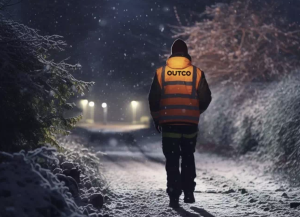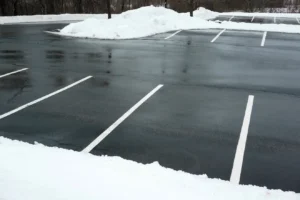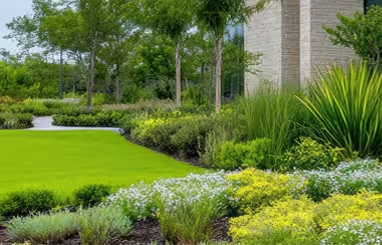At OUTCO we primarily use white salt as our main de-icing agent, due to white salt being slightly more effective, cleaner to use and more environmentally friendly than brown.
Winter gritting salt primarily comes in two varieties – white and brown , and in this article we look at the advantages and disadvantages of both.
White
White is much more sustainable than brown because it is collected from evaporated seawater. It’s more concentrated than brown and therefore is more effective as a de-icing agent.
Composition of white salt
99.99% pure
Advantages
- White is sustainable and more environmentally friendly, as it’s essentially evaporated seawater
- White gets to work faster than brown, as it’s 99.99% pure
- It does not leave behind a messy residue after spreading
- It’s perfect for high footfall areas or locations where it may be trodden into buildings or vehicles, as it does not leave behind brown stains.
Disadvantages
- Slightly more expensive than brown. However, it’s important to factor in other savings when using white. White will often save you time and money in the long run, as you won’t have to clean up left-over residue or stains.
Brown winter gritting salt
Brown salt is a mined resource and it gets its brown colour from the presence of impurities (often insoluble minerals), hence why a gritty residue is left behind. Brown salt is mainly used by local councils and the highways agency to spread on the roads as it’s cheaper than white salt.
Composition of brown
94% salt
6% impurities (clays, sand, iron oxide etc).
Advantages of brown
- Marginally cheaper to purchase than white salt.
Disadvantages of brown salt
- A non-sustainable mined resource that is not particularly environmentally friendly
- Site maintenance and clean-up is needed afterwards. Brown salt leaves behind a messy, gritty brown residue
- Causes staining, especially when trodden into buildings and vehicles, which is difficult and costly to remove
- High tendency to cause corrosion which accelerates the rusting of vehicles and the steel used in concrete.
Gritting in cold temperatures
In some circumstances, we prefer to use brown (grit) as it is often more effective at temperatures below -10 Celsius, which is extremely cold and seldom experienced in the UK.
Between 6-10% of brown is made from impurities (clay, sand and iron oxide etc), hence why a gritty residue is left behind. This solid residue can help to aid traction on slopes and provide vehicle tyres with additional “bite.”
Best of both
At OUTCO we continually adapt our gritting approach depending on the weather and site-specific needs. Spreading a blended mix of white and brown often ensures clients benefit from the best of both types of salt.
To find out how we can work together, or to obtain a free winter gritting quote or site inspection, please contact us today.









